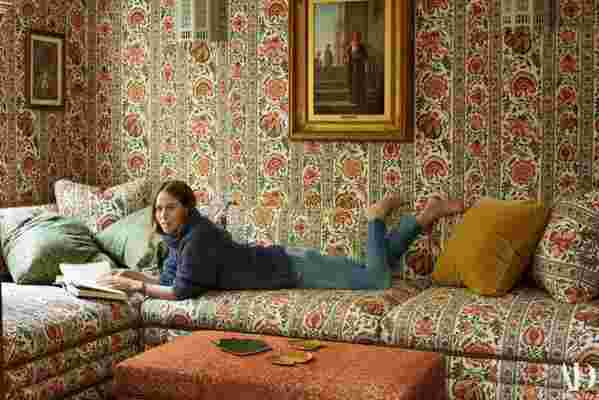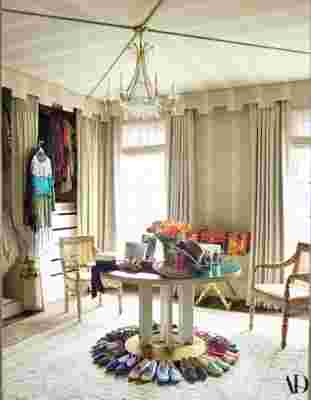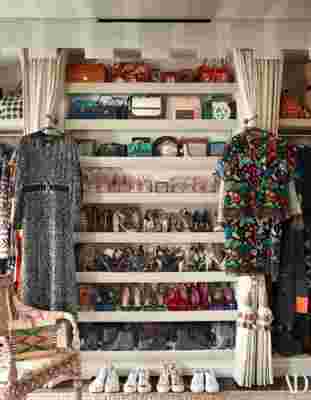Even the most intrepid world traveler needs a place to stow her luggage and rest her head. In other words, a place to call home. A couple of years ago, when her father decided to give up his house in central London, Nina Flohr decided to let go of her Notting Hill flat and take the opportunity to make the family home her own.
“I’ve always admired the way the English dress their houses, the great estates with their Colefax & Fowler furnishings and eccentric flourishes,” says the Swiss-born Flohr, who until 2016 served as the creative director of VistaJet, the fleet of superstylish private planes founded by her father in 2004. “I wanted to take that inspiration and create a beautiful space that reflects my personal style and taste, an easy place to entertain, and a cozy nest to return to after my travels.”
I’ve always admired the way the English dress their houses, those great estates with their Colefax & Fowler furnishings and eccentric flourishes.
To help her realize her vision, Flohr turned to London-based AD100 designer Veere Grenney , who worked at Sibyl Colefax & John Fowler in the 1990s before opening his own firm. Since then, he has forged a path as one of the leading torchbearers for the great English tradition of creating rooms that are both beautiful and comfortable, many of which can be seen in the just published Veere Grenney: A Point of View (Rizzoli). “Nina came to my office with her inspiration book—nearly 200 images!—which included plenty of my own work,” Grenney recalls. “I was so flattered, I couldn’t refuse.”
Nestling into the living room’s green Fortuny-clad sofa, Flohr starts to describe her brief for the space. “I grew up here, so it has lots of familiarity, but I had to make changes.” Refurbished in the 1990s, the interiors of the Regency-era neoclassical beauty were rather minimal—“contemporary,” in Flohr’s description.

Nina Flohr, wearing a Chanel sweater, lounges in her London home. The custom sofa, by Veere Grenney Assoc., and walls are covered in a Bennison printed linen.
She and Grenney dove right in, reconfiguring the floor plan. What had been the main drawing room on the second floor was transformed into Flohr’s bedroom and bath. (A separate, fancifully “tented” dressing room is just upstairs.) Her former bedroom in the basement was given over to creating a zone dedicated to cooking, dining, and entertaining. (In contrast to most renovations these days, they actually made the new kitchen smaller, in order to steal more space for the dining and bar area.) The ground floor was divided into living room, library, and a cozy fabric-lined TV room Flohr calls the “snug,” while the top-floor study became a pair of guest rooms.
Over the course of the project, the duo grew quite comfortable in their constructive back-and-forth. When Flohr proposed lacquering the walls of the ground floor, Grenney installed simple paneling first to create more visual interest in the low-ceilinged space; she suggested contrast piping for his pleated lampshades; he had the flamboyant Bennison fabrics she chose recolored to create sumptuously bespoke environments.

Loafers surround a vintage Swedish table in Flohr’s dressing room. Vintage inlaid Moroccan chairs; walls and curtains of a Sister Parish design linen-cotton.

Chanel (left) and Valentino frocks hang in the dressing room. The living-room sofa is upholstered in a Fortuny cotton.
“Nina’s taste is very eclectic, and she believes in quality and details,” says Grenney. “She is also a keen organizer and likes functionality. We had fun with color and pattern, but we also had to make it all work.” Great details and fine craftsmanship abound. The living room is swathed in a moss-green silk velvet, the same material the curtains are made of. A Bennison linen envelops the TV room’s walls and Turkish-style sofa. (The space was inspired by Cecil Beaton’s iconic 1966 portrait of Lee Radziwill with her daughter in their Renzo Mongiardino–designed house in London.) The dressing room is tented in light-green striped fabric, with Flohr’s tidy closets hidden behind the draped fabric that lines the walls.
Flohr’s personality is seen in the array of artworks and souvenirs on display: An Op Art painting by Victor Vasarely in shades of green—Flohr’s favorite color—hangs on a staircase landing; edgy contemporary artworks by Koen van den Broek and Clare Rojas adorn the bedroom; a vintage Fornasetti chest of drawers sits in the living room. Throughout the house, a visitor spots many photographs, artwork, and crafts from countries all around Africa; Flohr has nurtured a passion for the continent since she first visited Kenya at age 15. Since then, she has returned again and again. And a few years ago, she established the Kisawa Sanctuary, a nonprofit marine-research facility and community-empowerment program, on an island in Mozambique. (A luxury hotel is scheduled to open there in 2019.)
Keeping in mind her respect for the local vernacular, inclination toward vibrant colors, prints, and patterns, and taste for African objects and midcentury furniture, Grenney has conceived a glamorous yet down-to-earth space where the young entrepreneur can really feel at home. “This house is definitely Nina,” says the designer. “If you met her at a party when she’s all glammed up in beautiful clothes and accessories and she invited you over for tea, you would not be surprised.”
Flohr interjects, “The house feels very much like an extension of me, a visualization of who I am and what I represent.” What more could anyone ask from their home?“My best clients are what I call ‘inspired amateurs,’ and Nina is for sure one of them,” adds Grenney. “She loves clothes, furniture, gardens, pictures—she loves beauty wherever she finds it!”
